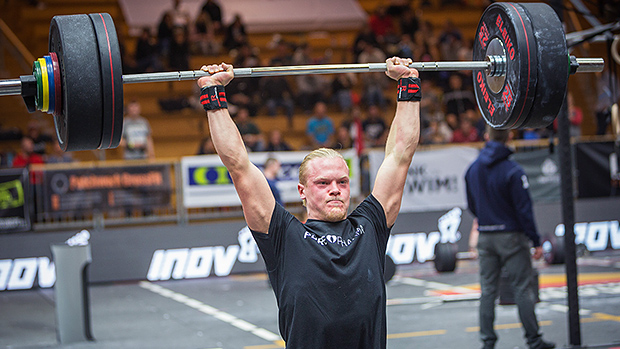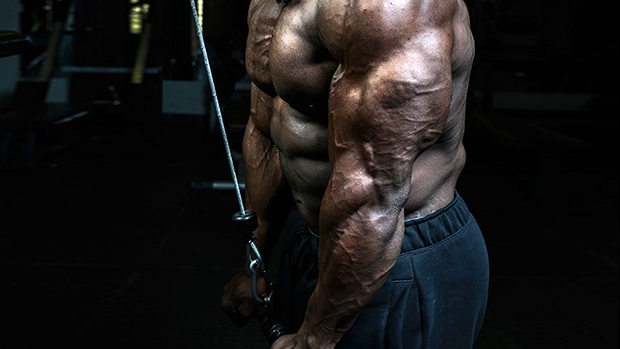Blood flow restriction (BFR) training is a specialized technique that can help you build sleeve-popping arms. It involves wrapping a restrictive implement such as bands or cuffs around the limbs while lifting.
This type of training comes with a warning though: Mind-blowing and sometimes painful pumps may be experienced.
Here's what you should know before diving in.
Research on hypertrophy shows a load of 65% or more is required to build significant muscle size. But research on BFR shows loads as low as 20-30% create the same muscle-building effect. That would mean you'd theoretically build as much muscle with 65 pounds as you normally would with 200.
The advantages of requiring less weight are obvious when it comes to rehab, as well as building muscle without undue stress on other body structures – the type of stress that causes elbow pain after a few weeks of heavy triceps training, for example.
Trying to grow your arms can sometimes feel like you're beating a dead horse. Week after week you hammer them hard with progressive overload, only to stop because your elbows and wrists have had enough.
If this sounds like you, then BFR could be a way to manage your training load, reaching a point where your stubborn arms finally start to grow.
Occlusion training allows arterial blood flow to a region, your arms in this case, while restricting venous return. Basically, you're allowing blood to flow into the muscle, but partially restricting its return out. To do this safely and effectively, using a purpose-made occlusion cuff is always best.
This occlusion results in an increase in Type II muscle fiber recruitment and an increase in localized growth hormone and IGF-1 levels (by up to 300%). In return, you'll see an increase in muscle protein synthesis by 45-55%, leading to greater muscular growth.
The benefits of occlusion training are largely seen distal to the occlusion device. For example, placing it high on your arm will provide benefits to the rest of the arm below the cuff. (There's some evidence to suggest that there are also benefits proximal to the cuff, though.)
Today you can find a number of implements made just for BFR training. These are generally better than knee or wrist wraps. Some lifters even use medical tourniquets, but a proper occlusion cuff is best. Researchers use specialty inflatable cuffs that measure the pressure. You can buy these online.
Cuff pressure is individual, depending on vasculature, tolerance level, or if you're using it over or under a shirt. Just remember, greater pressure from the cuff does not directly correlate to how hardcore you think you are.
Just keep it snug, not as tight as it'll go. For the upper arms, you're seeking around 100-220mmHg using an occlusion cuff, or a 7 out of 10 in intensity relative to your maximum tolerable level.
Place the cuff at the top of your upper arms. It's good if you've got a little pump prior to doing this. Find the right pressure and then begin your BFR training. You can leave the cuff on for up to 10-30 minutes, although if there's any sensation of numbness, tingling, or major discomfort, take it off immediately.
You can do this workout up to twice a week. You may feel you can do more or add in some extra exercises, but don't. The aim of this workout is to stimulate, rather than annihilate, your arms into growth.
To get your arms bigger you need to get them stronger too. That's why the workout will start with some heavy lifts (producing a lot of mechanical tension) before your actual BFR exercises.
The protocol often cited in research as having the greatest effects on hypertrophy is 30/15/15/15. This is exactly what you'll be using.
That means you'll squeeze a near-maximal 30 reps out of your first set. Thirty seconds later you'll aim for just 15 reps with the same weight, then do two more 15-rep sets. This will still be a struggle since your arms will have ballooned up!
- A. Weighted Dips or Decline Narrow Grip Bench Press: 4 x 5-7 with a 4-second eccentric (negative) tempo. Rest 2 minutes between sets.
- B. Seated or Scott Hammer Curl: 4 x 5-7 with a 4-second eccentric tempo. Rest 2 minutes between sets
- C. Overhead Triceps Extension with BFR: 4 x 30/15/15/15. Rest only 30 seconds between sets. (See video above.)
- D. Cable-Behind Biceps Curl with BFR: 4 x 30/15/15/15. Rest 30 seconds between sets. (See video above.)




